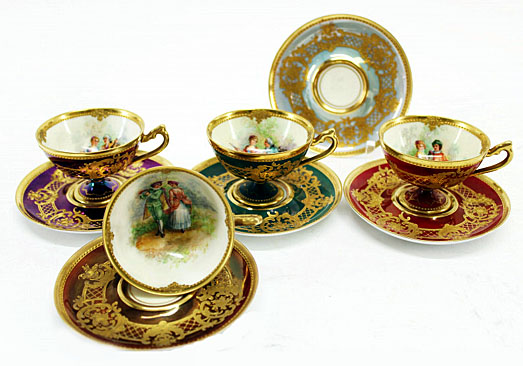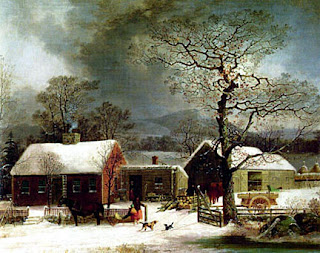 QUESTION: My grandmother has been collecting fancy cups and saucers for several decades. Some in her collection are simple in design, but others are artistically decorated. Two sets have an unusual shape with pedestal cups decorated with ornate paintings. The mark on the bottom of the cup and saucer is a blue lamb with the word "Dresden" below it. Who produced these cups and saucers and when were they made?
QUESTION: My grandmother has been collecting fancy cups and saucers for several decades. Some in her collection are simple in design, but others are artistically decorated. Two sets have an unusual shape with pedestal cups decorated with ornate paintings. The mark on the bottom of the cup and saucer is a blue lamb with the word "Dresden" below it. Who produced these cups and saucers and when were they made?
ANSWER: Chances are that the two cups and saucers in your grandmother’s collection are from Dresden, Germany. Ceramic factories such as Rosenthal and Meissen produced blanks that were later decorated by independent studios. Ambrosius Lamm owned and operated one of the top decorating studios, producing consistently high quality wares.
 The city of Dresden became a leading cultural center in the 17th century. In the 18th century, the city became known as the "Florence on the Elbe" because of its magnificent Baroque architecture and its outstanding museums. Artists, especially porcelain decorators, took up residence there.
The city of Dresden became a leading cultural center in the 17th century. In the 18th century, the city became known as the "Florence on the Elbe" because of its magnificent Baroque architecture and its outstanding museums. Artists, especially porcelain decorators, took up residence there.
Between 1855 and 1944, more than 200 painting studios existed in the city. The studios bought porcelain white ware from manufacturers such as Meissen and Rosenthal for decorating, marketing and reselling throughout the world. Ambrosius Lamm owned one of the top decorating studios consistently producing high quality wares.
Lamm operated a porcelain painting studio and arts and antique shop from 1887 to 1949. It was located at Zinzendorfstrasse 28 in Deesden. He had approximately 25 employees by 1894, which grew to about 40 in 1907.
 studio became well known for painting in the Meissen, Vienna, and Copenhagen style. Lamm's specialties included Old Dresden flowers, Watteau and mythology, as well as decorated luxury and utility articles in the old and new styles. Lamm bought blanks from a number of manufacturing firms, including Meissen, Rosenthal, Hutschenreuther and Silesia.
studio became well known for painting in the Meissen, Vienna, and Copenhagen style. Lamm's specialties included Old Dresden flowers, Watteau and mythology, as well as decorated luxury and utility articles in the old and new styles. Lamm bought blanks from a number of manufacturing firms, including Meissen, Rosenthal, Hutschenreuther and Silesia.
Lamm used at least three different marks by Lamm, including a pensive angel with Dresden and Saxony, an L within a shield, and the most common mark, an outline of a lamb with Dresden underneath.
He also produced cabinet cups and saucers. Middle and upperclass Victorians often had display cabinets in their dining rooms in which they displayed fine decorated plates and cups and saucers. A set of six flared cups with scrolled handles, hand painted with French court beauties, such as Mme. Lebrun, sell for between $3,000 and 4,500.
 Collectors can still find desirable cabinet cups, as well as sherbets and goblets can be found, decorated on Rosenthal blanks with a gilt cutout star or flower inside the cup. Usually, well-painted portraits of men and women in period dress appeared on the outside with heavy gold paste work.
Collectors can still find desirable cabinet cups, as well as sherbets and goblets can be found, decorated on Rosenthal blanks with a gilt cutout star or flower inside the cup. Usually, well-painted portraits of men and women in period dress appeared on the outside with heavy gold paste work.
Lamm often used rich cobalt blue and luster glazes for his ground colors. His favorite decorative techniques were jeweling and beading. His studio was well known for using heavy intricate gold paste work on borders of plates and cups.
 also enjoyed painting cherubs or putti. Many of his pieces featured cherubs holding fruit, flowers, and playing musical instruments. He often portrayed them floating amid fluffy clouds.
also enjoyed painting cherubs or putti. Many of his pieces featured cherubs holding fruit, flowers, and playing musical instruments. He often portrayed them floating amid fluffy clouds.
His paintings on porcelain cups and saucers and cabinet plates rivaled the quality of Royal Vienna and Sevres porcelains. For example, he pronounced a series of 12 plates portraying ones from various oil paintings displayed in the famous Scamper Gallery in the Zwinger Palace. These plates had cobalt blue borders with elaborate gold paste gilding.
Lamm’s excellent reputation as a top porcelain decorator encouraged wealthy families in Germany and abroad to commission demitasse sets and dinner services from his studio. These sets included the monogram of the owner in intricate gold work. Examples for sale today include dinner plates and serving items with one to four hand-painted courting scenes within medallions on the border.
 occasionally decorated dinnerware with the floral and gilt patterns typically used by other Dresden studios. But he preferred to be more creative in his designs. His studio produced a line of dinner and tea ware featuring bold, large vibrant flowers covering each piece. Lamm’s studio was particularly known for its artistic rendering of flowers.
occasionally decorated dinnerware with the floral and gilt patterns typically used by other Dresden studios. But he preferred to be more creative in his designs. His studio produced a line of dinner and tea ware featuring bold, large vibrant flowers covering each piece. Lamm’s studio was particularly known for its artistic rendering of flowers.
To read more articles on antiques, please visit the Antiques Articles section of my Web site. And to stay up to the minute on antiques and collectibles, please join the over 30,000 readers by following my free online magazine, #TheAntiquesAlmanac. Learn more about militaria in the 2022 Fall Edition, with the theme "After-Battle Antiques," online now. And to read daily posts about unique objects from the past and their histories, like the #Antiques and More Collection on Facebook.


















